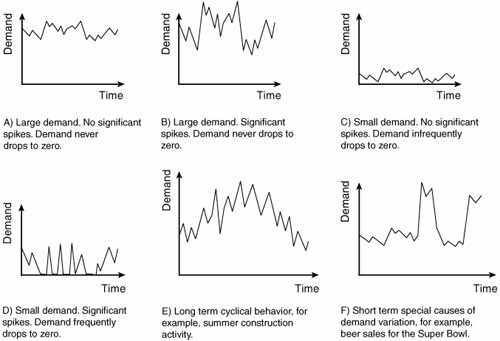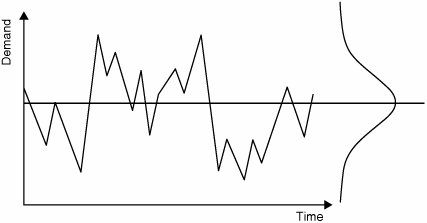Section 15. Demand Profiling
15. Demand ProfilingOverviewDemand Profiling is simply the application of a Time Series Plot to the Customer demand on a process. It is considered a tool in its own right because
Figure 7.15.1 shows a simple Demand Profile plot. Demand data is captured over time at uniform[24] time intervals and plotted with an x-axis of Time and a y-axis of Demand. The plot highlights the likely average demand on the process and also the likely variation in demand to which the process has to respond.
Figure 7.15.1. A simple Demand Profile. LogisticsAs a simple analysis tool this can be applied by the Belt without the rest of the Team, however the data might have to come from multiple sources and often requires Team involvement to collect it. The analysis itself is done entirely in a spreadsheet or statistical package and can be done in a matter of a few minutes after the data is in the correct format. Initially, data is historical, but after the organization understands the application of the tool, forecast data can also be used. Roadmap
Interpreting the OutputThere are some important points to consider when examining the Demand Profile. The purpose of creating the profile was to understand, from historical data, future volume and variation in demand. Using historical data might be misleading; so the first question to consider is whether future usage patterns are expected to be similar to those in the past. It is always useful to study the market and technology changes and factor these into the analysis. In effect, the Demand Profile is being used as a rudimentary forecasting tool, but rather than using the data to determine how much to generate on a short-term basis, it is used to create a more responsive and capable process. Demand Profiles can exhibit one or combinations of a multitude of patterns, the most common of which are shown in Figure 7.15.2. See the "Interpreting the Output" section in "Demand Segmentation" in this chapter. Graph A represents a Zone 1 Demand Profile, whereas Graph D represents a Zone 3 Demand Profile. Figure 7.15.2. Interpreting the Demand Profile. The value that Demand Profiling brings above and beyond Demand Segmentation is that cyclical patterns become visible. Rather than just knowing that there is variation, the Belt obtains an understanding of how the demand is varying. After this is understood, the process can be laid out and resourced accordingly. For example, if there are significant spikes in demand at the end of each day:
However, the demand is dealt with from the Demand Profile, without visibility of the variation from the graph, the process is always at its mercy. Other OptionsAlthough Demand Profiling is simply the use of the graphical tool the Time Series Plot, an obvious extension is the application of statistical analysis to the plot data. Analysis of this form relies on interpolation techniques similar to Regression. Although extremely valuable as an enhanced version of Demand Profiling, it is a difficult and complex subject considered outside the skill set of Black Belts and Green Belts and is considered beyond the scope of this book. In simple terms the interpolation techniques break down the time series data into its component parts, namely:
|
EAN: 2147483647
Pages: 138
